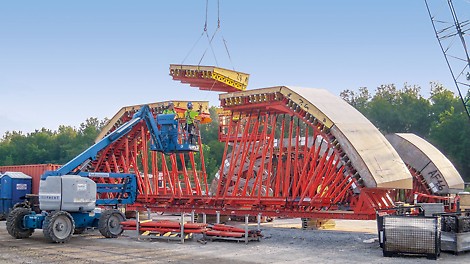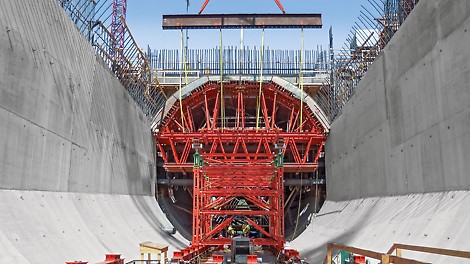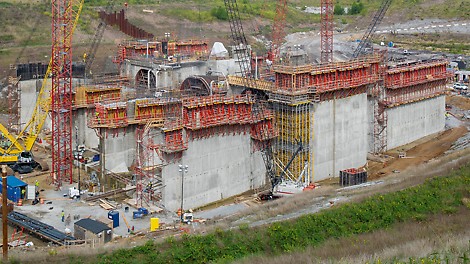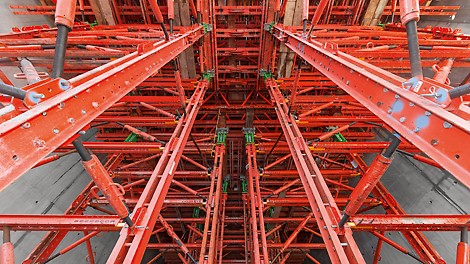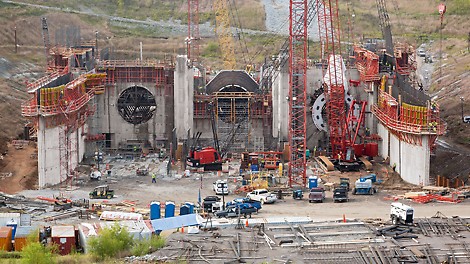
The Smithland hydroelectric plant is located on the Ohio River in Kentucky and will have a capacity of 72 MW. The C.J. Mahan Construction Company, LLC is responsible for the realization of the power plant shell including the intake structure and discharge channel. The power plant itself consists of three horizontal bulb turbine units each with a capacity of 24 MW, and one generator unit; it is more than 78 m long, approx. 62 m wide and 32 m high. A time frame of only 18 months was earmarked for the reinforced concrete work of this massive structure while a very high degree of dimensional accuracy due to the technical installations is also required.
In order to realize these challenges, the construction company commissioned PERI not only for the planning of the formwork and shoring solution but also for the fabrication of the 3D formwork units as well as partial assembly of a wide range of shoring structures. In addition, PERI provided a project manager on site which has ensured optimum coordination of all planning, assembly and delivery operations regarding the formwork and scaffolding technology.
3D formwork units – project-specific planning, pre-assembly and delivery
In particular, the realization of the concrete structures in the area of the bulb turbine units is a very complex procedure because the dimensions of the circular shaped slabs and numerous multiple curved walls constantly change over the whole length: over a length of approx. 27.50 m, the tube diameter increases from 11.40 m to almost 18.00 m. The complete solution was developed by means of 3D formwork planning, originating from the overall structure while taking into consideration the range of geometries as well as the maximum transport dimensions of individual formwork elements. Raised formwork units consisting of SLS spindles and RCS rails – supported on VARIOKIT heavy duty shoring towers – carry this shape providing formwork unit for the walls and the massive, more than 4.00 m thick reinforced concrete slab.
The 3D team in Weissenhorn was responsible for the dimensionally accurate planning of around 3,700 m² of special formwork and subsequently handed over the detailed drawings to their colleagues in the United States. The PERI formwork assembly facility in Chicago is in charge of pre assembling the multi curved formwork units using customized timber formers created using CNC woodworking equipment and organizes the just in time delivery to the construction site. Many of the formwork units are used only once as the tight construction schedule requires the simultaneous realization of all three tubes. In addition, the high loads generated when concreting the slab in each of the up to four sections require a long utilization period of the formwork and scaffolding.
PERI also delivered the VARIOKIT bracing and heavy duty shoring towers in pre assembled units. Final assembly is then carried out on site very similar to system formwork and scaffolding, supported by site compliant general arrangement drawings. This approach minimizes both the assembly time and expense as well as space requirements on the jobsite. Furthermore, the stationary prefabrication ensures the required, high degree of dimensional accuracy of the structure.
System formwork and scaffolding in use
Due to the tight construction schedule, the possibility of multiple usage is only very limited also for the system formwork. Thus, among other things, approx. 9,000 m² of TRIO panel formwork and 90,000 m of GT 24 formwork girders are being used. As rentable system components are in use as much as possible, the project is nevertheless economically viable. PERI has excellently maintained equipment in appropriate quantities at its disposal and can therefore continually supply the power station construction site reliably and on time without any problem. In addition, the extensive PERI product portfolio ensures that the right equipment is used for the respective application. One example of this can be found in the shoring: depending on requirements, simple slab props, compact shoring towers or heavy duty shoring towers are used – each optimally adapted to suit the load and height. In this way, material usage for each application is minimized.
The fact that the formwork and scaffolding technology can be utilized extremely flexibly while simultaneously being easy and safe to handle, makes the execution of the construction work particularly efficient. For example, the system components of the VARIOKIT engineering construction kit can be used for all raised formwork units with a wide range of shapes and loads as well as for heavy duty shoring towers. The site compliant connections and the easy adaption to different geometries and loads accelerate the work of the construction team.
Innovative SCS climbing technology
A widely used system on site is the single sided SCS climbing system – a further development of the previous SKS system – which has already proved itself in the expansion of the Panama Canal. With the SCS, the loads from the fresh concrete pressure are transferred, without formwork ties, via the brackets into the climbing anchor of the previous concreting section. For the construction of the massive walls, no anchors are therefore necessary which would subsequently require time consuming sealing operations. This results in significant cost savings in the realization of the structure.
SCS is characterized by its high degree of cost effectiveness because, thanks to the modular concept with its multi part bracket, it can be optimally adapted to the geometry of the structure without any effort. Due to the particularly high load bearing capacity of the brackets, along with and the best possible anchoring utilization, large climbing units are possible which further accelerates work operations. The fact that the separate working platform can always be horizontally aligned when used on inclined structures, makes working on the platforms particularly safe.
An all round appropriate concept – everything from one source
One of the biggest challenges for the execution is the very tight construction schedule; of particular importance is, therefore, problem free implementation of all processes and work procedures. As a result, the solution concept devised by the teams of PERI engineers from the U.S. and Germany took into account the specific project requirements including all cost considerations and deadlines. Planning, assembly and scheduling are completely synchronized and matched to suit the construction progress. Furthermore, the construction team is supported by a PERI project manager at any given time so that all daily formwork and scaffolding operations on the construction site are fully coordinated as well as being constantly adapted and optimized accordingly.
The outstanding advantages for the building contractor are that both the planning – and thus the optimal coordination of formwork and shoring – as well as the delivery of all materials is from a single source. This saves on interfaces and reduces frictional losses in the construction process.
Smithland Hydroelectric Power Plant
The Smithland hydroelectric plant will use water from the existing Smithland lock installation and adjoining dam for generating electricity. By means of discharging water through the bulb turbine units, the power plant will generate approx. 379 million kWh (gross annual output). Construction of the new power plant began in September 2010 and up to 400 people are working on site at any one time in order to ensure on-schedule workflows. Mahan is responsible for the reinforced concrete work, and the company started operations in April 2012 with the excavation work and the erection of a temporary cofferdam. Completion of the power plant is scheduled for 2015.
